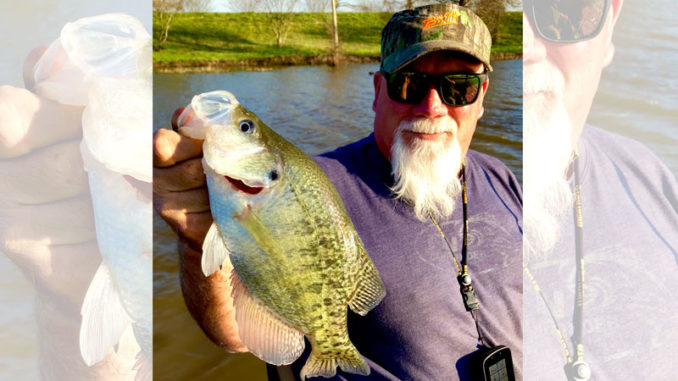
Catch post-spawn slabs right from your “easy chair” with this effective technique
One reason crappie fishing is growing faster than a 90-mile-an-hour fastball is that fishermen are learning more and more ways to catch the tasty fish.
Using new techniques not only provides enjoyment, but it also increases the angler’s chance for a livewell full of fish.
Enter long-lining.
“I was in Mississippi fishing with some of the B’n’M Poles pro staff and got to see them do it one day,” John Godwin said. “I’d never seen it before, but it worked. I thought it was going to require a lot of fancy equipment, but you can do it very simply.”
Godwin, one of the stars of the Duck Dynasty TV series and long-time Duck Commander team member, said the reason you should learn to long-line is simple.
“You can cover a lot of water and a lot of fish with a minimum amount of effort,” he said. “It takes a few minutes to get set up, but once you are, you’ve got eight baits in the water going right where you know the fish are.”
And, he reminds us, it gets back to why we fish in the first place.
“Look, it’s just a fun way to fish. It’s an easy way to fish,” he said. “I mean, here I am, sitting in my big Millennium easy chair, feet propped up, watching my big-screen Humminbird TV with my Minn Kota remote control in my hand, and I’m pulling in crappie for supper. I’d say that’s pretty awesome.”
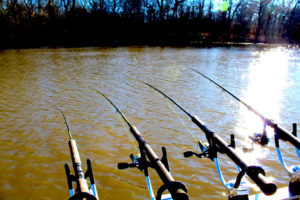
Godwin puts both of his fishing chairs in the stern and arranges four poles in rod holders on each side of his boat. He normally uses 8-, 10-, 12- and 14-foot lengths, but sometimes, if the fish are spooky, he’ll go even longer on the outside poles. The key is to have two-foot increments so the lures cover more water and keep from getting tangled.
“Here’s what the deal is,” he said. “These fish are moving off the beds and onto the flats this time of year, and you want to find flats with some sort of contour change like an old ditch, stumpline or small variation in depth. You can see on your electronics where the fish are holding and about what depth they are.
“At 1 mile an hour — the speed I usually go this time of year — I use different-size jigs for different depths. I use a 1/32-ounce to keep the bait at 3 feet deep, a 1/16- to keep the bait at 4 to 5 feet and a 1/8- to keep the jig at 7 to 8 feet. It’s important to vary depths until you get on the fish, then key on that one depth. And remember, crappie will swim down to eat, but they prefer to feed up. Always keep your bait about a foot above the crappie, ’cause when he’s hungry, he’s looking up.”
There are charts online that show the depths many popular lures run, based on speed and line size. Some anglers long-line with crankbaits; again, the key to making the lure work is keeping it in the strike zone.
Godwin uses his remote-control trolling motor to keep the boat on course, and he tries to keep it over where he sees fish on his depth finder as he passes by. Often this time of year, the outside poles will catch the most fish; some fish spook as the boat passes overhead.
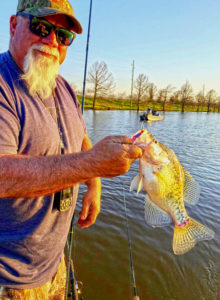
While rod holders on the gunwales are the easiest and most-productive ways to set out rods, Godwin said you can fish a modified long-lining rig out of any boat.
“I know people that sit up front and put their variable-speed trolling motor on low, hold one pole in each hand and long-line like that. Obviously, the more poles you have in the water, the more bites you usually get, but you can catch them with just two poles,” he said.
The keys are keeping the bait at the right depth, staying in areas holding fish and going the right speed. This time of year, some fish are a bit timid, and you have to slow your speed just a bit. When you do, you can adjust the amount of line you let the bait out behind the boat to keep the lures from going too deep. Just turn the reel handle a few times. Jigs are best for long-lining, but when the bite is slow, you might want to try tipping the jig with a live shiner or a crappie bite to add a little more incentive for the fish.
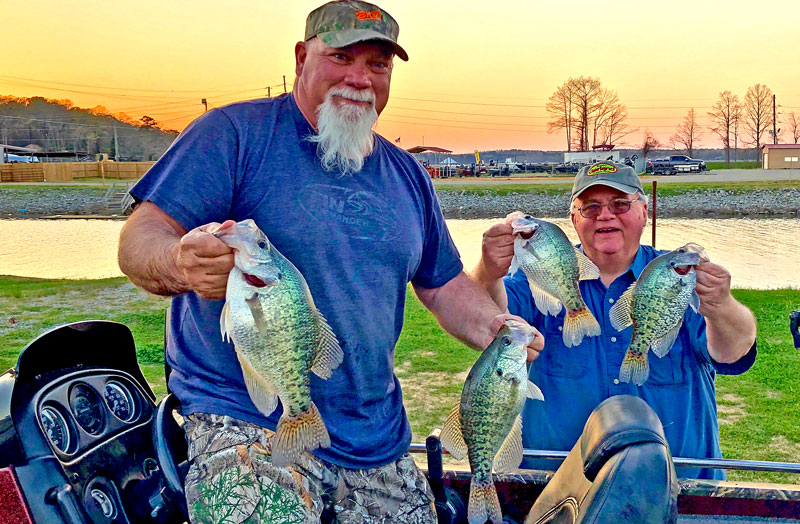
This technique will work anywhere you can find crappie. While it is ideal for the flats this time of year, it also works in all kinds of water. The easiest fishing is when crappie are scattered in areas where there aren’t too many stumps, but long-lining is designed to fish anywhere. Godwin said any lake or river is prime long-line territory.
When fishing deeper water at other times of the year, Godwin said to look for shad pods, then troll right below the wad of baitfish. That’s where the fish will be hanging out, waiting to swim up and get a bite of dinner.
“Never be scared to try something new like long-lining,” he says. “With just a little time and practice, you can learn new ways to catch fish. That just adds more fun to the trip and more fish to the grease at the house.”
And as he said in one of his funny lines on the Duck Dynasty show,
“This is funner than chuckin’ rocks at a sign.”
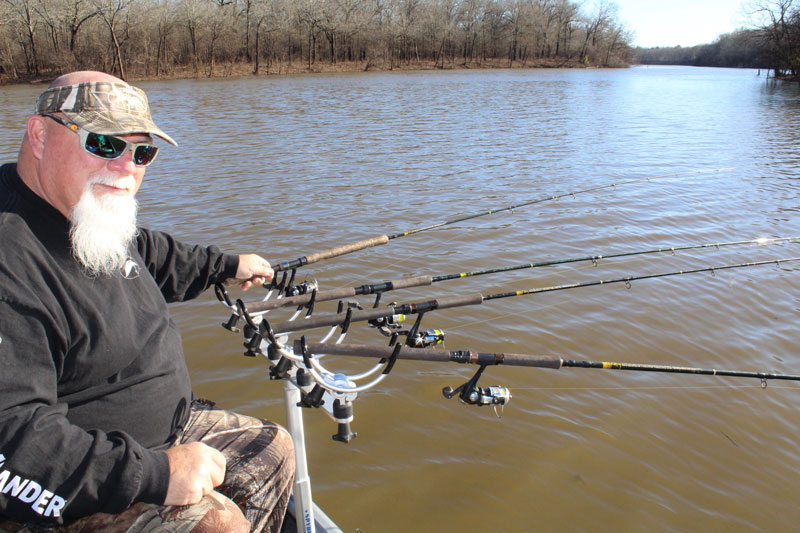
We’re going to do what?
I’ve been fortunate enough to spend several days crappie fishing with John Godwin of Duck Dynasty and Duck Commander fame. We usually fish with a single pole or maybe a spider rig, but the last time, he had me baffled.
“Now let me get this straight, John,” I said. “We’re going to put the two fishing seats in the back of the boat, throw out curlytail Fin Spin lures in various colors from two sets of crappie poles, each set containing a 6-, 8- and 10-foot rod. Then, we are going to troll four poles apiece out of the back of the boat, even though the trolling motor is up front? Who’s going to watch where we are going?”
“That’s it,” Godwin replied, guiding the boat with his trolling motor’s remote control straight across a big flat where the water was 8 to 9 feet deep, surrounded by a 14- to 15-foot deep natural sloughs on each side. “I’ll keep an eye out up front and make sure we don’t run into anybody. You keep an eye on the poles. If they twitch, you set the hook. And we are going to go 1 mile an hour. That’s the key. Throw out the bait closest to the motor first, the middle one second and then the long pole last. If you get hung, just pull it straight to you. We can’t stop or all six baits will get hung. Hey, I bet you a ham sa’mich we catch a fish before you even get that last pole set.”
Okay, I did. And then we did. The last bait had just hit the water when the first pole started jerking and bending. It was a nice pound-and-a-half crappie.
What we were doing is called long-lining. It’s not really new, but not many folks use it in Louisiana. It isn’t for the faint of heart; it’s sort of like spider-rigging in reverse, and it takes a special knack. You get hung up some. Fish bite and swim across the other lines and tangle them on occasion. But it catches fish. And isn’t that why we go?
“I love long-lining because we can cover a lot of ground and, I can actually watch the Humminbird and see when we pass over fish. You can know when you are going to get a bite a lot of the time,” Goodwin said.
Sure enough. He said a minute later, “Look at the fish on the depth finder. We should catch one in about 10 seconds.” Nine…eight…..two…one..Thump! We did.
Godwin became famous for his role on the Duck Dynasty TV show, but he is just as passionate about crappie fishing as he is duck hunting — maybe even more so. And going on a trip with him is as much fun as watching an episode of the show on TV. And he even won a ham sa’mich.
And we both ate fresh crappie for supper. I’m in.
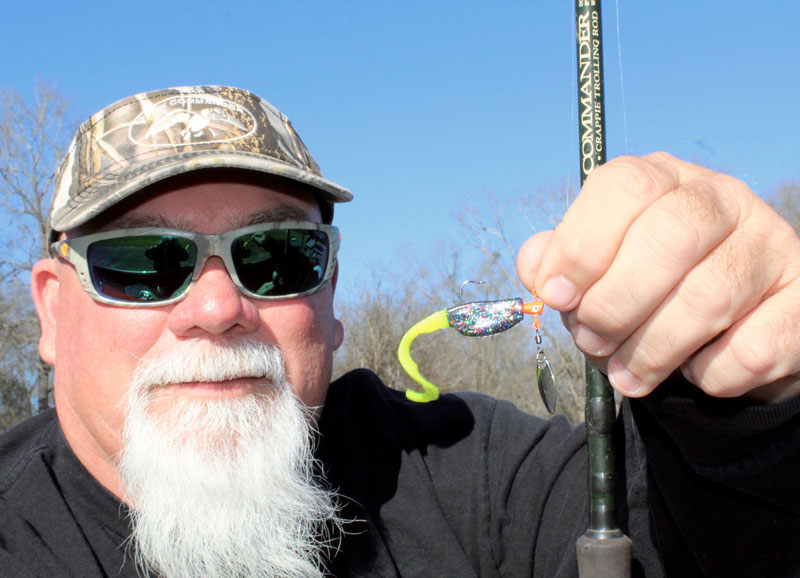
Godwin’s pick for long-lining
It should come as no surprise what’s at the top of the list of John Godwin’s choices for long-lining crappie. It’s the B’n’M Duck Commander series crappie rod, one he helped design. He uses two sets of rods, one for each side of his boat, in 8-, 10- and 12-foot lengths.
His favorite reel is the Pro Series 100 spinning reel because it is smooth and has a great drag system, which is important when dragging in slabs while the boat is moving. His favorite lure for long-lining is the Fin Commander Slab Curly. He likes it because it has a curlytail that will work as slow as .3 miles per hour. It took some work to get that developed, but a slow, spinning tail is something crappie can’t resist. His traditional favorite colors are monkey milk and mermaid, but the new mardi gras color has fast moved up the list. One color that seems to work all across the country is black/chartreuse.
Godwin uses 6-pound test line and likes Crappie Magnet SOS line. You need to use the same line on each reel so you know your lures are running the same depth, because lures run deeper on lighter line. One point he makes is that if you are in clear water, you should use clear line. Everywhere else, he uses hi-vis line. His rod holders are Millennium Marine, but he likes DriftMasters as well.


